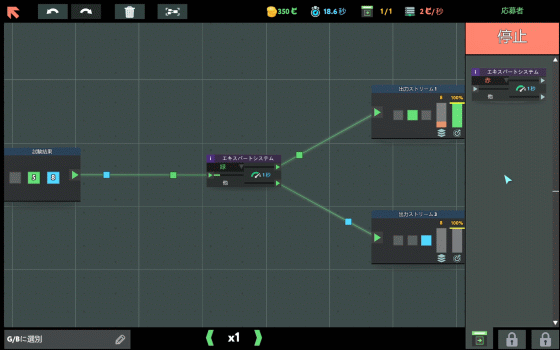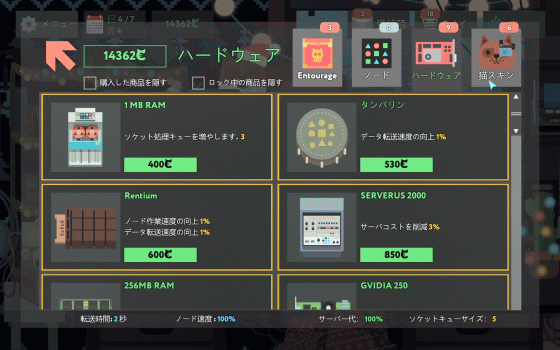Review of 'while True: learn ()', a puzzle simulation game where you can learn machine learning and neural networks from the development site of a cat language translation system.

' While True: learn () ' is a puzzle action game where you can learn machine learning while making various requests in order to develop a machine learning system that can translate the words of cats. 'While True: learn ()' represents the Python code of the programming language, which means 'repeat the process called learn ()', that is, 'continue learning'. Since it is distributed on
while True: learn ()
https://store.steampowered.com/app/619150/while_True_learn/?l=japanese
Below is a movie that creates a machine learning system with while True: learn ().
Creating a machine learning system with 'while True: learn ()' looks like this-YouTube
The main character is a freelance engineer.

The hero who suffers from bugs that cannot be solved by any means.

When the hero leaves his seat for coffee ...

All the cats are on the sofa.

I started to operate something in front of the PC.

When the hero returns to the desk ...

What a bug was solved.

The hero is also surprised at this.

Recognizing the talent of cats as programmers, the main character decided to work on various tasks in order to build a machine learning system that can translate the words of cats ... The story of the game.

From here, the actual play. The home screen of while True: learn () looks like this. Move to the task list from 'Tree' at the top right of the screen.

The tasks are arranged in a tree, and you can try the next task by clearing one task.

The game screen looks like this.

The 'node' that is the main body of the program is located on the right side. Nodes have processing time, for example, an 'expert system' takes 1 second per process. By combining these nodes, we will realize various processes called 'schemes'.

On the left side, the data to be entered into the node is displayed along with the number of data. The data types are divided into 'red', 'blue', and 'green' colors and '□', '△', and '○'.

The output stream on the right shows the type of data to output, the number of data, and the accuracy. For example, in the case of output stream 1 at the top, it is necessary to store eight green '□' with 100% accuracy. The basic way to play while True: learn () is to combine nodes well to create a scheme, sort the data and output it appropriately.

First, place the node in the field by dragging and dropping.

This time I want to separate the 'green' and 'blue' inputs into separate outputs, so I'll set the node to output 'green' and 'other' with an expert system that can separate colors.

Nodes can be connected by dragging and dropping ' ▶ ' to each other.

Click 'Run Test' when the scheme is complete.

Data flows from left to right, the data is sorted by the nodes, and goes to different outputs.

The scheme does not just have to move, but there are limits to the 'processing time' and 'number of nodes used'. In addition, the scheme runs on a cloud called 'Cat Cloud', and it is charged every second according to the processing. Cloud costs will be deducted from the reward later, so the point is to develop a scheme that is as efficient as possible.

The data flow speed can be adjusted 0.5 to 3 times faster with the button at the bottom.

When the scheme meets the requirements, a clear screen will be displayed, so release the scheme with 'Release'.

I got a reward from 'CAT CASH' excluding the server fee 'Cat Cloud'.

The earned CATCASH is the interior of the room ...

You can use it to purchase items that make the program easier, cat costumes, and so on.

In this way, the story progresses by completing the tasks in the task tree in order.

When a node with a new concept such as '

Programs developed in the process of advancing the game can be reused from the buttons in the red frame.

If you reuse the program well, you can simply build the program.

There is also a special task called 'Startup' that has a graph icon instead of a cat icon.

As the name implies, a startup is a task that participates in startup project development.

In a real-life startup, the situation is constantly changing and flexible response is required, so it is possible to release the scheme immediately without testing even within while True: learn ().

Startups, unlike single-shot tasks, can continue to benefit. You can check the profit status from the menu screen and click 'Next day' to advance the date by one day.

After a certain number of days, the project's profits have become less profitable. In such a case, sell the startup stock with the button in the red frame.

The key to making a profit at a startup is to sell your stock at the right time.

Some nodes require 'learning'.

By learning, you can improve the accuracy of discrimination.

Some of them become 'teachers' and regulate their actions ...

Some nodes do '

As the game progresses, the scheme becomes more complex. However, don't worry, you will be guided to clear the tasks if you complete the tasks in order. Although the Japanese translation is quite suspicious, while True: learn () was a game that 'somehow makes me feel like I understand machine learning' even for people who do not understand programming at all, let alone machine learning.

'While True: learn ()' is distributed on Steam and can be purchased for 937 yen including tax until January 6, 2021.
29% off on Steam: while True: learn ()

Related Posts:







